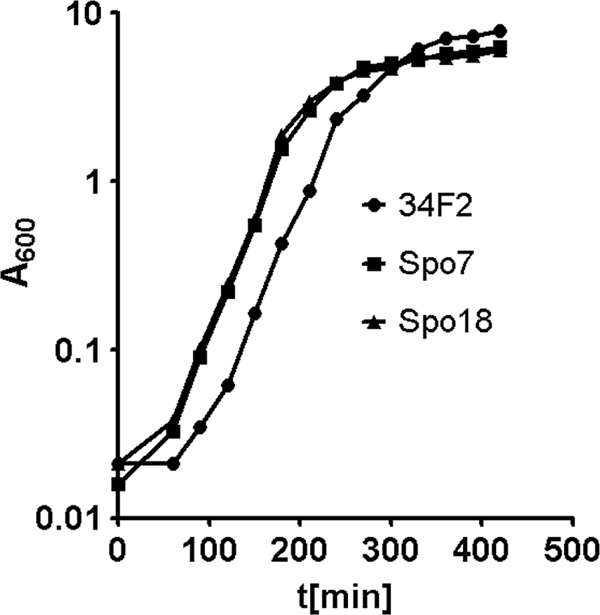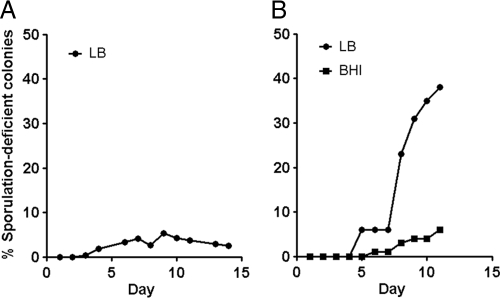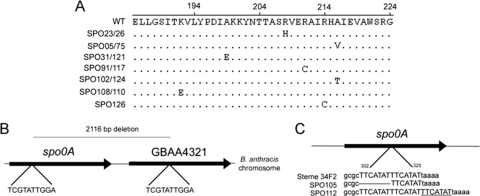Abstract
We demonstrate the frequent accidental enrichment of spontaneous sporulation-deficient mutants of Bacillus anthracis on solid medium and identify contributing factors. Mutations in spo0A, encoding the master regulator of sporulation initiation, were found in 38 of 53 mutants. Transductions using bacteriophage CP51 propagated on sporogenic bacteria allowed for the restoration of sporulation phenotypes.
Bacillus anthracis is an endospore-forming bacterium and the etiological agent of anthrax. Bacillus spores are formed under conditions of high bacterial density or nutrient limitation; they are metabolically inert and resistant to unfavorable conditions, such as extreme temperatures, pH, and desiccation (27). Spores can reside in the soil for many years until inhaled by grazing animals, whereupon germination and vegetative growth is initiated, accompanied by production of toxins and the antiphagocytic capsule, ultimately leading to anthrax disease and death (27).
Sporulation and germination in Bacillus are complex processes requiring the orchestrated action of many genes. Sporulation transcription factor Spo0A is a DNA-binding protein and master regulator for entry into sporulation; it controls the expression of more than 120 genes directly (16), and its activity influences the expression of approximately 12% of the entire genome (3). Spo0A belongs to the family of bacterial response regulators (7), and activated Spo0A binds to a 12-bp consensus sequence located within promoter sequences (16, 28), thereby activating or repressing downstream genes (17, 24). Due to its pivotal role, mutations within Spo0A leading to inactivity result in complete loss of sporulation (6).
Bacteria constantly experience spontaneous mutation, which has been found to occur at a frequency of 10−7 to 10−9 per base pair per generation (11). The observation that asporogenic mutants quickly overtake a continuous culture has been made for several spore-forming organisms, including Bacillus sphaericus (8), Bacillus thuringiensis (21), and Bacillus subtilis (14). Spontaneous Bacillus mutants defective in their ability to sporulate are useful tools to identify and characterize the function of genes involved in sporulation (1, 4, 6, 23). However, accidental and/or unrecognized selection of such mutants is disadvantageous, especially during routine lab passage of strains and, e.g., generation of targeted genetic deletions, since many such mutants are intended to be used for spore challenge of animals to test virulence. We have noticed that this selection occurs frequently in different strains of B. anthracis (unpublished data). This work aimed to characterize asporogenic B. anthracis mutants, to identify factors influencing their selection, and to find methods for reverting accidentally selected mutants to a sporogenic phenotype.
For our studies, we used B. anthracis Sterne, an attenuated strain harboring virulence plasmid pXO1 but devoid of plasmid pXO2 (9). We observed that after a 2-day incubation period at 37°C, B. anthracis often exhibits two distinct colony phenotypes on LB agar plates, with the majority of colonies being flat and white in color, but a small percentage (<1%) being larger with a translucent appearance. Microscopic analysis in combination with the killing of vegetative bacteria by heat treatment (65°C for 30 min in water) showed that the larger colonies harbored asporogenic bacteria, thereby allowing an easy visual identification of such mutants on LB agar. To identify factors favoring enrichment of asporogenic mutants, we compared the following three conditions: (i) age of colonies, (ii) number of passages, and (iii) influence of media. For the age of colonies, we generated an LB master plate by plating a dilution of a single sporogenic B. anthracis colony and each day picked different colonies from the master plate, diluting them and plating them onto new LB plates. Phenotypic analysis of about 1,000 colonies showed an increase in the percentage of asporogenic bacteria in correlation with the age of the master plate (Fig. 1 A). After day 9, the frequency of asporogenic bacteria decreased, presumably representing lysis of sporulation-deficient B. anthracis mutants present on the master plate. For evaluation of the number of passages and the influence of media, sporulating colonies (n = 100) were serially passaged on two different solid media. Figure 1B shows that on LB plates, the number of colonies consisting of asporogenic bacteria increased greatly with the increasing number of passages. In contrast, on brain heart infusion (BHI) plates, this percentage never exceeded 10%, indicating BHI agar to be a better medium for avoiding enrichment of sporulation mutants. However, we found that mutants are visually not as easily identifiable on these plates as on LB agar; only after complete lysis of asporogenic bacteria had occurred on BHI agar was it possible to visually identify such mutants, therefore exacerbating early recognition and counterselection.
FIG. 1.
Influence of the number of passages, media, and age of colonies on frequency of asporogenic mutants. (A) Percentage of sporulation-deficient mutants derived from colonies of different ages. (B) Percentage of asporogenic mutants retrieved from subsequent passages of 100 individual colonies.
For Bacillus cereus, sporulation stage 0 mutants can be enriched under nitrogen-limiting growth conditions, and several mutants were found to harbor mutations in Spo0A (15, 18). To investigate the possible role of this regulator, we sequenced spo0A in 53 asporogenic mutants using primers Sposeq1 (TTGTCGAACAATTCATGTAGCC) and Sposeq2 (TCAAGAATGATTAAGCTTTATGAAAA). Table S1 in the supplemental material lists the 38 strains found to have mutations in spo0A; the majority (n = 21) displayed missense mutations that may not affect function of Spo0A. However, the DNA-binding motif of Spo0A is located between amino acids 193 and 224 (28), and 13 of the mutants harbored 7 different mutations in this region (Fig. 2 A), most of which could be expected to lead to loss of regulatory function. Other mutants (n = 16) harbored nonsense mutations, insertions, or deletions, thus clearly affecting functionality of Spo0A. In one of the analyzed mutants (LL44), which was derived in a separate experiment from B. anthracis strain UM44-1C9 (12), illegitimate recombination occurred, an event that takes place between short direct repeats (2, 26). Consequently, a 2,116-bp fragment in the spo0A region starting at a 10-bp direct repeat present in the coding region of spo0A and ending at an identical repeat within the downstream gene was deleted in that strain (Fig. 2B), as determined by sequencing with primers Sposeq1 and Sposeq5 (TTCATAAATGCAAATGCCTCA). Furthermore, we found that a 7-bp direct repeat (TTCATAT) within the coding region of spo0A was altered in 2 other mutants, either by deletion (SPO105) or duplication (SPO112), both of which disrupt the reading frame (Fig. 2C). These mutations are likely caused by replication errors or slipped-strand mispairing (SSM), often found to occur at tandem repeats (13). Interestingly, we found the strain harboring the 7-bp duplication to spontaneously revert to the wild type (data not shown), thereby restoring Spo0A function. This offers a strategy in which genetic manipulations, such as gene knockouts, could be performed in this mutant strain, since the preexisting spo0A mutation removes the selective pressure that would enrich for other spontaneous mutations in sporulation genes. After all the intended genetic changes are introduced, the final strain could be reverted to the wild-type spo0A genotype.
FIG. 2.
Schematic overview of mapped spo0A mutations caused by illegitimate recombination and replication errors. (A) Amino acid sequence alignment of the helix-turn-helix motif of sporulation mutants harboring missense mutations in this region. Seven different amino acid substitutions were found in the isolates listed on the left. (B) A region of 2,116 bp between two 10-bp direct repeats present in spo0A and GBAA4321 in the chromosome of wild-type B. anthracis was deleted in strain LL44, eliminating the C terminus of Spo0A and the N terminus of the adjacent protein. (C) A 7-bp direct repeat within spo0A was deleted in strain SPO105, whereas the same repeat was duplicated in mutant SPO112 (underlined); both mutations led to loss of Spo0A activity.
For B. subtilis, it was reported that mutations in some sporulation genes, such as spo0A, result in higher intracellular fluxes of metabolites and increased biomass yield (4). We evaluated the growth characteristics of two of the B. anthracis asporogenic mutants, one harboring an insertion (SPO7) and the other a deletion (SPO18) (Fig. 3). While the wild type had a significantly (P < 0.001, by analysis of variance [ANOVA] and Tukey's posttest) prolonged lag phase, mutants SPO7 and SPO18 quickly entered exponential growth phase (Table 1); however, growth rate differences during logarithmic growth proved to be insignificant (P = 0.46, by ANOVA with Tukey's posttest) (Table 1). These results show that loss of sporulation in B. anthracis can lead to a shortened lag phase but does not give bacteria an advantage during exponential growth.
FIG. 3.

Growth curve of wild-type strain 34F2 in comparison to those of two asporogenic mutants. Bacteria were inoculated in LB from an overnight culture and grown over a period of 7 h. A600, absorbance at 600 nm.
TABLE 1.
Comparisons of bacterial lag phases (Tlag) and doubling times (Td) of strains grown in LBa
| Strain | Tlag (min) | Td (min) |
|---|---|---|
| Sterne 34F2 | 101.7 ± 14.4 | 25.1 ± 1.4 |
| SPO7 | 68.9 ± 9.3 | 24.2 ± 2.5 |
| SPO18 | 70.0 ± 4.3 | 25.7 ± 1.7 |
| SPO91 | 94.4 ± 14.2 | 26.3 ± 0.9 |
Results are the means ± standard deviations from three independent experiments.
Generating genetic knockout mutants is a time-consuming process, even though improved and faster mutagenesis approaches have been described for B. anthracis (10, 19, 20). If a final deletion mutant proves to be asporogenic, it must be considered that the sporulation defect is a secondary mutation unrelated to the gene under study. To overcome this problem, we sought a faster approach that allows for the restoration of sporulation and attempted to use phage transduction to introduce DNA from sporogenic into asporogenic mutants, ultimately reverting asporogenic mutants to the wild-type phenotype. We selected two mutants with spo0A mutations known to result in inactivity (SPO18 and SPO128) and one with a missense mutation that could leave Spo0A functioning (SPO91) (see Table S1 in the supplemental material). For transductions, a heat-sensitive derivative of Bacillus phage CP51 (25), isolated from B. cereus strain 569 (CP51+) grown in BHI agar (0.5% glycerol) at 30°C for 15 h, was first propagated in sporulation-competent B. anthracis by mixing 1 ml phage suspension with 1 ml vegetative B. anthracis (grown for 5 h in LB containing 0.5% glycerol). Phage assay (PA) agar (5) was added to the phage-bacterium mixture, which was then overlaid onto nutrient broth-yeast extract (NBY) plates (5) containing 0.5% glycerol and incubated at 30°C for 30 h. Phages from entire plates were harvested in 5 ml PA broth, sterile filtered (0.45-μm filter [Millipore]), and used for transductions of asporogenic mutants SPO18 and SPO128 by incubating 1 ml of phage suspension with 1 ml of asporogenic, vegetative bacteria grown as described above. Phage-bacterium mixtures were incubated for 1 h at 37°C (which prevents phage replication and cell lysis), grown on sporulation plates (22) at 37°C under lack of selective pressure for 3 to 5 days, and subsequently heat treated to eliminate nonsporulating bacteria prior to plating on LB agar. Each transduction experiment yielded several viable (i.e., sporulation-competent) colonies, which were confirmed microscopically, and no spontaneous, sporogenic revertants were obtained in parallel control experiments. Subsequent sequencing of the sporulation-competent transductants revealed that the mutations present in SPO7 and SPO18 were eliminated after phage transduction. In contrast, the missense mutation present in SPO91 (R211C) remained, indicating that it did not alter Spo0A function since the transductants readily formed spores. Therefore, mutation of a different gene was responsible for the loss of sporulation in mutant SPO91, and it was this unidentified mutation that was corrected by transduction. This result shows that for reversion of asporogenic mutants accidentally enriched in the laboratory, phage transductions can be a powerful method for restoring sporulation caused by mutations in an unknown location, thereby allowing the rescue of an otherwise desirable strain.
Taken together, this work describes an easy method to detect asporogenic mutants on agar plates, describes media and lab techniques that may help to prevent accidental selection, and provides an approach to restore the sporogenic phenotype in accidentally selected mutants. Although under laboratory conditions the loss of sporulation and mutation of spo0A was a frequent event, it remains unknown how often and whether this phenomenon occurs in nature.
Supplementary Material
Acknowledgments
This work was supported by the Intramural Research Program of the NIH, National Institute of Allergy and Infectious Diseases.
We thank K. Ramamurthi for his helpful suggestions and critical reading of the manuscript.
Footnotes
Published ahead of print on 16 July 2010.
Supplemental material for this article may be found at http://aem.asm.org/.
REFERENCES
- 1.Brehm, S. P., H. F. Le, and J. A. Hoch. 1975. Deoxyribonucleic acid-binding proteins in vegetative Bacillus subtilis: alterations caused by stage 0 sporulation mutations. J. Bacteriol. 124:977-984. [DOI] [PMC free article] [PubMed] [Google Scholar]
- 2.Ehrlich, S. D., H. Bierne, E. d'Alencon, D. Vilette, M. Petranovic, P. Noirot, and B. Michel. 1993. Mechanisms of illegitimate recombination. Gene 135:161-166. [DOI] [PubMed] [Google Scholar]
- 3.Fawcett, P., P. Eichenberger, R. Losick, and P. Youngman. 2000. The transcriptional profile of early to middle sporulation in Bacillus subtilis. Proc. Natl. Acad. Sci. U. S. A. 97:8063-8068. [DOI] [PMC free article] [PubMed] [Google Scholar]
- 4.Fischer, E., and U. Sauer. 2005. Large-scale in vivo flux analysis shows rigidity and suboptimal performance of Bacillus subtilis metabolism. Nat. Genet. 37:636-640. [DOI] [PubMed] [Google Scholar]
- 5.Green, B. D., L. Battisti, T. M. Koehler, C. B. Thorne, and B. E. Ivins. 1985. Demonstration of a capsule plasmid in Bacillus anthracis. Infect. Immun. 49:291-297. [DOI] [PMC free article] [PubMed] [Google Scholar]
- 6.Hoch, J. A. 1976. Genetics of bacterial sporulation. Adv. Genet. 18:69-98. [DOI] [PubMed] [Google Scholar]
- 7.Hoch, J. A. 2000. Two-component and phosphorelay signal transduction. Curr. Opin. Microbiol. 3:165-170. [DOI] [PubMed] [Google Scholar]
- 8.Idachaba, M. A., and P. L. Rogers. 2001. Production of asporogenous mutants of Bacillus sphaericus 2362 in continuous culture. Lett. Appl. Microbiol. 33:40-44. [DOI] [PubMed] [Google Scholar]
- 9.Ivins, B. E., J. W. Ezzell, Jr., J. Jemski, K. W. Hedlund, J. D. Ristroph, and S. H. Leppla. 1986. Immunization studies with attenuated strains of Bacillus anthracis. Infect. Immun. 52:454-458. [DOI] [PMC free article] [PubMed] [Google Scholar]
- 10.Janes, B. K., and S. Stibitz. 2006. Routine markerless gene replacement in Bacillus anthracis. Infect. Immun. 74:1949-1953. [DOI] [PMC free article] [PubMed] [Google Scholar]
- 11.Keim, P., J. M. Gruendike, A. M. Klevytska, J. M. Schupp, J. Challacombe, and R. Okinaka. 2009. The genome and variation of Bacillus anthracis. Mol. Aspects Med. 30:397-405. [DOI] [PMC free article] [PubMed] [Google Scholar]
- 12.Koehler, T. M., Z. Dai, and M. Kaufman-Yarbray. 1994. Regulation of the Bacillus anthracis protective antigen gene: CO2 and a trans-acting element activate transcription from one of two promoters. J. Bacteriol. 176:586-595. [DOI] [PMC free article] [PubMed] [Google Scholar]
- 13.Levinson, G., and G. A. Gutman. 1987. Slipped-strand mispairing: a major mechanism for DNA sequence evolution. Mol. Biol. Evol. 4:203-221. [DOI] [PubMed] [Google Scholar]
- 14.Maughan, H., J. Masel, C. W. Birky, Jr., and W. L. Nicholson. 2007. The roles of mutation accumulation and selection in loss of sporulation in experimental populations of Bacillus subtilis. Genetics 177:937-948. [DOI] [PMC free article] [PubMed] [Google Scholar]
- 15.Michel, J. F., B. Cami, and P. Schaeffer. 1968. Selection of Bacillus subtilis mutants blocked at the beginning of sporulation. I. Asporogenous pleotrophic mutants selected by growth in a nitrate medium. Ann. Inst. Pasteur (Paris) 114:11-20. [PubMed] [Google Scholar]
- 16.Molle, V., M. Fujita, S. T. Jensen, P. Eichenberger, J. E. Gonzalez-Pastor, J. S. Liu, and R. Losick. 2003. The Spo0A regulon of Bacillus subtilis. Mol. Microbiol. 50:1683-1701. [DOI] [PubMed] [Google Scholar]
- 17.Perego, M., G. B. Spiegelman, and J. A. Hoch. 1988. Structure of the gene for the transition state regulator, abrB: regulator synthesis is controlled by the spo0A sporulation gene in Bacillus subtilis. Mol. Microbiol. 2:689-699. [DOI] [PubMed] [Google Scholar]
- 18.Piggot, P. J., and J. G. Coote. 1976. Genetic aspects of bacterial endospore formation. Bacteriol. Rev. 40:908-962. [DOI] [PMC free article] [PubMed] [Google Scholar]
- 19.Pomerantsev, A. P., A. Camp, and S. H. Leppla. 2009. A new minimal replicon of Bacillus anthracis plasmid pXO1. J. Bacteriol. 191:5134-5146. [DOI] [PMC free article] [PubMed] [Google Scholar]
- 20.Pomerantsev, A. P., R. Sitaraman, C. R. Galloway, V. Kivovich, and S. H. Leppla. 2006. Genome engineering in Bacillus anthracis using Cre recombinase. Infect. Immun. 74:682-693. [DOI] [PMC free article] [PubMed] [Google Scholar]
- 21.Sachidanandham, R., and K. Jayaraman. 1993. Formation of spontaneous asporogenic variants of Bacillus thuringiensis subsp. galleriae in continuous cultures. Appl. Microbiol. Biotechnol. 40:504-507. [Google Scholar]
- 22.Sastalla, I., K. Chim, G. Y. Cheung, A. P. Pomerantsev, and S. H. Leppla. 2009. Codon-optimized fluorescent proteins designed for expression in low-GC gram-positive bacteria. Appl. Environ. Microbiol. 75:2099-2110. [DOI] [PMC free article] [PubMed] [Google Scholar]
- 23.Seredick, S. D., B. M. Seredick, D. Baker, and G. B. Spiegelman. 2009. An A257V mutation in the Bacillus subtilis response regulator Spo0A prevents regulated expression of promoters with low-consensus binding sites. J. Bacteriol. 191:5489-5498. [DOI] [PMC free article] [PubMed] [Google Scholar]
- 24.Strauch, M., V. Webb, G. Spiegelman, and J. A. Hoch. 1990. The Spo0A protein of Bacillus subtilis is a repressor of the abrB gene. Proc. Natl. Acad. Sci. U. S. A. 87:1801-1805. [DOI] [PMC free article] [PubMed] [Google Scholar]
- 25.Thorne, C. B. 1968. Transducing bacteriophage for Bacillus cereus. J. Virol. 2:657-662. [DOI] [PMC free article] [PubMed] [Google Scholar]
- 26.Weisberg, R. A., and S. Adhya. 1977. Illegitimate recombination in bacteria and bacteriophage. Annu. Rev. Genet. 11:451-473. [DOI] [PubMed] [Google Scholar]
- 27.World Health Organization. 2008. Anthrax in humans and animals. World Health Organization, Geneva, Switzerland.
- 28.Zhao, H., T. Msadek, J. Zapf, Madhusudan, J. A. Hoch, and K. I. Varughese. 2002. DNA complexed structure of the key transcription factor initiating development in sporulating bacteria. Structure 10:1041-1050. [DOI] [PubMed] [Google Scholar]
Associated Data
This section collects any data citations, data availability statements, or supplementary materials included in this article.




